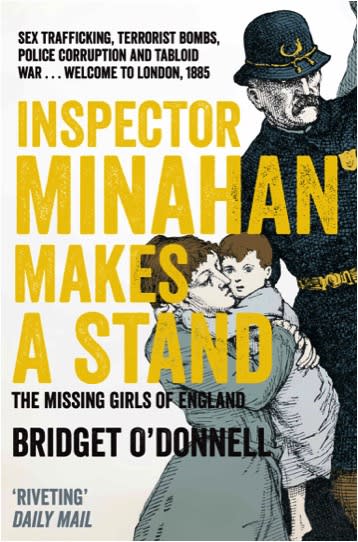
The Brits at the Folies-Bergère?

A new interpretation of Edouard Manet’s final masterpiece,
A Bar at the Folies-Bergère (1881-2)
Carefully placed within Manet’s iconic, Parisian scene of a barmaid at the Folies-Bergère in Paris, are two rather incongruous bottles of ordinary English ale. Positioned to the left and right of the bar, the two bottles of Burton-on-Trent’s finest Bass beer are distinguishable by the red triangle on their label, Britain’s first ever registered trademark. Above them, the barmaid’s famously ambiguous expression suggests a wealth of unspoken emotion. She appears resigned but unhappy, young but fatigued, contained behind the bar while seemingly pushing at it, resisting its force. She seems trapped.
Though Manet – being part of the Impressionist school - denied entertaining ‘ideas’ (philosophical or political) in his paintings, his major works are often, nonetheless, layered with meaning and symbolism.
In this, his final masterpiece (he died in 1883), Manet created a direct and lifelike portrait inside the Folies-Bergère, yet his image remains characteristically evasive: stark, disengaged and slightly seamy. But the bottles of Bass stand out clearly. Why were they there?
Most art historians attribute their presence to the English tourists who frequented the Folies-Bergère. Other experts consider the distinctive red trademark a comment on the rise of commercial culture in Parisian society. Arguably there is be a different theory: that Manet placed the Bass bottles prominently to highlight that there were more attractive English goods on sale at the Folies-Bergère than just beer.
My book, Inspector Minahan Makes a Stand, (Picador), examines how English girls were traded across the Channel and into the brothels of Paris, Brussels and Berlin during the early 1880s. A Bar at the Folies-Bergère was completed by Manet during 1881-2 and exhibited in the wake of an international exposé of this ‘immoral traffic’, which resulted in the prosecution of a gang of French and Belgian traffickers in Brussels in December 1880 and April 1881. Both trials were widely reported in France.
At the same time, there was a secondary trade in British ‘barmaids’ to the French cafés-concerts (or cafés-chantants), of which the Folies-Bergère was the most famous. Inveigled into these establishments by touts and employment agencies in London, on their arrival in France the English girls soon discovered that they were not only there to sell mediocre champagne. Rather like lap dancers today, the barmaids of the cafés-concerts were expected to earn their money from their male clientele. They did not work for a wage, they worked for tips – with all the tacit compromises that this engendered.
During my research for Inspector Minahan I found - among several similar accounts - the case of two British girls named Carrie Mountford (aged 18) and Lizzie Cox (17), who were employed at a French café-concert in the early 1880s. Believing that they had secured respectable positions through the ‘Hetherington’s Agency’ on the Strand, they found instead that their Gallic café-concert was a kind of ‘gay house’ (brothel) and ‘the mistress wanted [them] to sleep’ with a group of ‘captains’ who counted as their customers. When finally rescued and returned by steam-packet from Le Havre, Inspector Minahan was privately employed to meet them at Southampton and escort them safely home to London.
By 1886, another 4,000 British girls ‘working’ in Paris had sought refuge from the ‘city of sin’ inside a rescue home there run by an Englishwoman named Ada Leigh.
Was the girl at the centre of Manet’s painting then, meant to appear British?
At the centre of the bar, drawing the viewer’s eye up to the barmaid’s pale décolletage and bereft face stands a small glass vase containing two roses. Their soft violet and peach tones resemble the girl’s own skin, a colouring – together with her strawberry blonde hair – much more akin to an ‘English Rose’ than the dark-haired Parisian girl rendered in Manet’s Olympia (1863).
In framing the barmaid between two bottles of Bass beer, Manet was perhaps making a small but serious point about the predicament of British girls in Paris, rather than adding a throwaway remark on British tourism. And if we accept this suggestion, then surely this explains the girl’s blank, fearful expression. For Manet - the master of equivocation - appears to have caught his subject in the midst of a very real but rather ugly realization: that her only way to survive in France was to sell her ‘virtue’.
Aptly, Manet’s masterwork was later bought by an Englishman, Samuel Courtauld, who founded the Courtauld Institute of Art, where this painting is still on prominent display. There is an irony that the Courtauld Gallery is currently situated in Somerset House on the Strand in central London. In the 1880s this same building held many public records and registrations, including birth certificates. Inspector Minahan Makes a Stand reveals how international traffickers used to purchase random birth certificates from Somerset House for a few pence. This allowed their underage girls to be falsely transported overseas and officially instituted in the brothels of Paris and Brussels where the age of the women was restricted to over 21.
Did Samuel Courtauld and his wife Lil pick up on these British links when they came to purchase this work in the 1920s? Perhaps, but this painting - which celebrated its 140th anniversary last year – seems to reveal a nefarious traffic in young, naive women that continues to this day... as the recent case of Jeffrey Epstein and Ghislaine Maxwell sadly demonstrated.
Uncover Untold Stories and Explore Historical Depths
Embark on a journey through captivating narratives and delve into the hidden corners of history with Bridget O'Donnell. Contact her today to unearth untold stories, engage in thought-provoking discussions, or explore collaboration opportunities that shed light on the past and resonate with the present.
Contact
Location
LondonOther website
www.davidhigham.co.uk/agents-dh/andrew-gordon